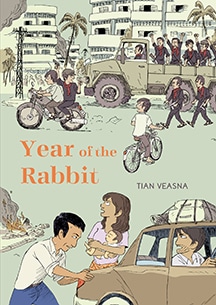
Year of the Rabbit
- Non-fiction
- Set in Cambodia
Keywords: graphic novel, translation, politics, resilience, family
Year of the Rabbit tells the true story of one family’s desperate struggle to survive the murderous reign of the Khmer Rouge in Cambodia. In 1975, the Khmer Rouge seizes power in the capital city of Phnom Penh. Immediately after declaring victory in the war, they set about evacuating the country’s major cities with the brutal ruthlessness and disregard for humanity that characterized the regime ultimately responsible for the deaths of one million citizens.
Cartoonist Tian Veasna was born just three days after the Khmer Rouge takeover, as his family set forth on the chaotic mass exodus from Phnom Penh. Year of the Rabbit is based on firsthand accounts, all told from the perspective of his parents and other close relatives. Stripped of any money or material possessions, Veasna’s family found themselves exiled to the barren countryside along with thousands of others, where food was scarce and brutal violence a constant threat.
Year of the Rabbit shows the reality of life in the work camps, where Veasna’s family bartered for goods, where children were instructed to spy on their parents, and where reading was proof positive of being a class traitor. Constantly on the edge of annihilation, they realized there was only one choice—they had to escape Cambodia and become refugees. Veasna has created a harrowing, deeply personal account of one of the twentieth century’s greatest tragedies.
Year of the Rabbit was translated by Helge Dascher. Dascher has been translating graphic novels from French and German to English for over twenty years.
In Year of the Rabbit, Tian Veasna recounts his life during the reign of terror in Cambodia from 1975 to 1979. Told from the perspective of one family, the book describes the brutal policies that all Cambodians endured under the Khmer Rouge regime. Year of the Rabbit focuses on some of those who escaped.
Connections to Literature
Teachers of literature may choose to use this graphic novel in conjunction with other texts about leaving home or as cross-curricular material to explore the topic of genocide in a history class. One text that might be used alongside Year of the Rabbit is Night by Elie Wiesel, which highlights Wiesel’s own experience during the Nazi regime and the Holocaust. Additionally, Year of the Rabbit provides new insights into a part of history not usually covered in textbooks.
Isolation
To be able to isolate and kill without feeling the horror of what they’re doing, persecutors will label their victims as “other” and isolate them.
Refugee Experiences
This text explores the hardships and tragedy that result from having to leave everything to survive, and how such decisions can affect one’s fate. In A Long Walk to Water, author Linda Sue Park shares the tale of Salva and his survival during the Sudanese civil war, and the decisions his family had to make in their war-torn country. We Are Not from Here by Jenny Torres Sanchez focuses on three young men at the U.S.–Mexico border. It shows the struggle to survive and make a better life.
Grade Levels
This book is recommended for upper-middle and high-school students (grades 8–12), for use in humanities, world history, psychology, and Asian studies. The subject matter highlights the extreme violence that occurs during genocide, which could be too intense for younger readers.
Suggestions for History, Social Studies, and Humanities
This text shares the ways some people can be misled by political leaders, believing the “strong man” will free the people and solve issues the country faces. This is how many in Phnom Penh felt. The visual maps in each chapter are helpful for readers and connect to the National Social Studies Standards.
Refugee Experiences
This text shares the story of those who were part of the Republic being forced out of the city. They were told they were being evacuated to protect them from American bombing, which was a lie. Students explore refugee stories in world history, U.S. history, and European history courses; teachers could make various connections to, for example, the displacement of Native Americans as settlers moved west, and the vast number of displaced persons (DPs) after World War II.
Racism and Xenophobia
Year of the Rabbit describes the struggle of refugees to find a new home after being driven from their community. They leave with hopes for safety and freedom, only to be judged and labeled “other” in the places they arrive. Loss of the familiar and the effort to find oneself are relatable ideas for teens, and they connect to the National Social Studies Standards of Individual Development and Identity and Culture.
Experiential Learning Activities
A family tree is provided at the beginning of the book, and at the end, readers can see who survived. Students could complete a family tree of their own family or of someone who survived persecution using research skills found in National Social Studies Standards of Global Connections and Individual Development and Identity.
Students can explore the Cambodian genocide in the Case Studies portion of the United States Holocaust Memorial Museum: https://www.ushmm.org/genocide-prevention/countries/cambodia
Cambodia Genocide and Continuing Effects by Colgate University Peace and Conflict Studies (14-minute podcast video): https://www.youtube.com/watch?v=7BXvThs8FqQ
Refugee Timeline: https://refugeehistory.org/timeline-refugee
Readings and Resources
- Anti-Defamation League. “Pyramid of Hate.” 2018. https://www.adl.org/sites/default/files/documents/pyramid-of-hate.pdf
- Association for Asian Studies. “Teaching Cambodian Genocide Through Film,” Education about Asia: Online Archives, Fall 2021. https://www.asianstudies.org/publications/eaa/archives/teaching-cambodian-genocide-through-film/
- Park, Linda Sue. A Long Walk to Water. HarperCollins, 2011.
- Salinger, J. D. Catcher in the Rye. Little, Brown, and Company, 1951
- Sanchez, Jennifer Torres. We Are Not from Here. Viking Books, 2021.
- Wiesel, Elie. Hill and Wang, 2006.
Author: Mandy Perret, Gifted Teacher
2024
Best International Book – Harvey Award (2020)
Top of the List and Editor’s Choice – ALA/YALSA (2020)
